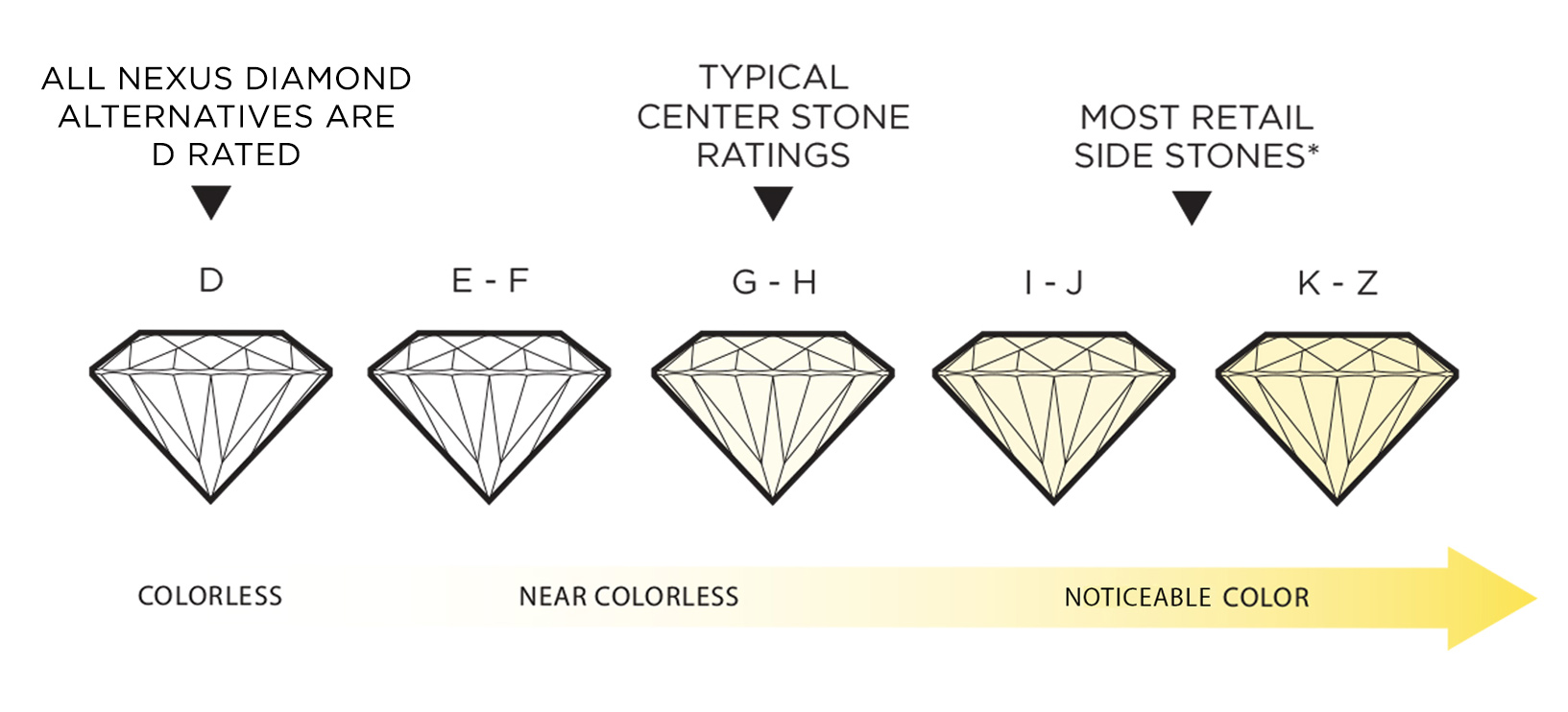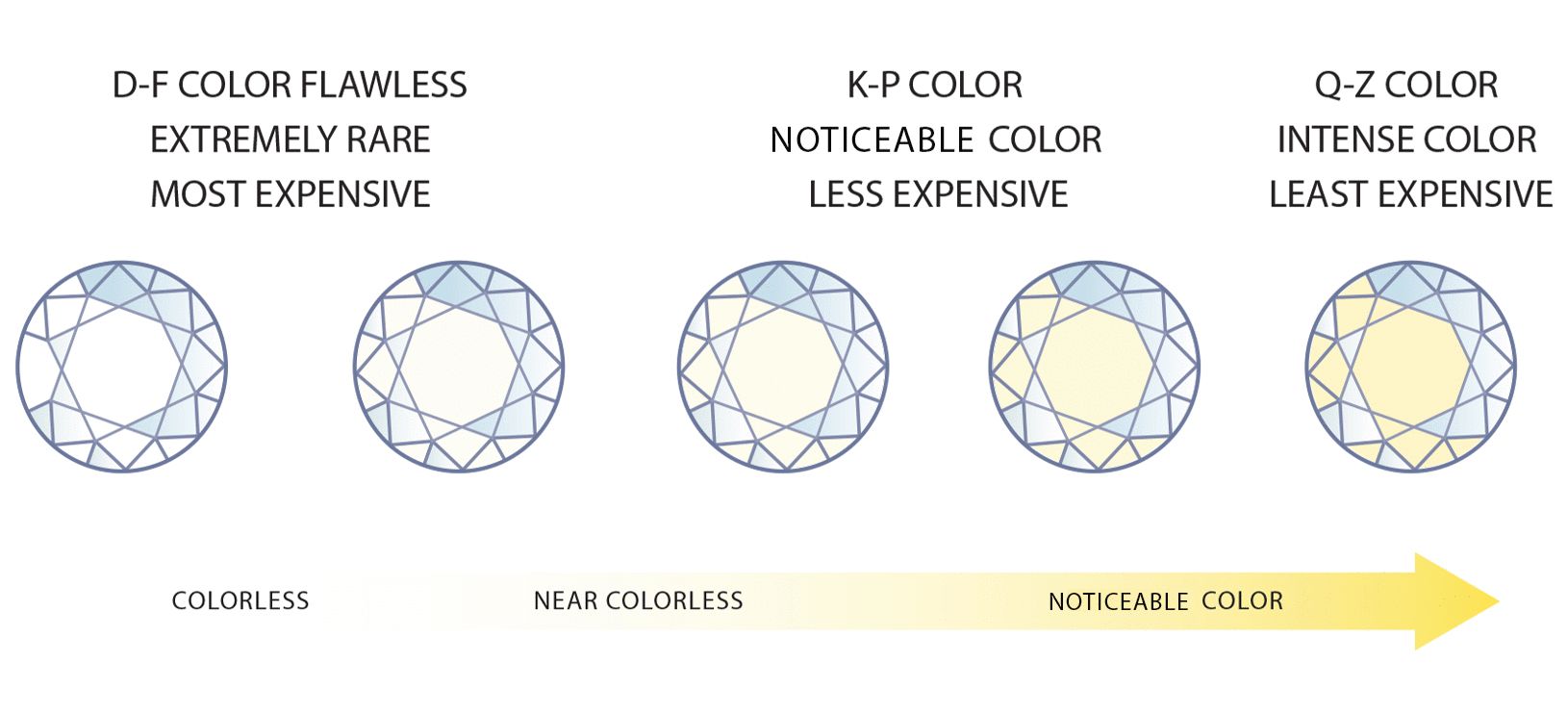What Is a Colorless Diamond: Characteristics, Cost, and More
January 2nd, 2024 / Alese Oldenburg
Diamond color is one of the key indicators of a lab grown diamond’s quality, and its color is far more complex than you may think. While some people may seek out rare stones in pink, blue, and emerald shades, someone looking for a classically bright, white diamond will want to select a colorless diamond or near colorless diamond.
While it is easy to tell if a diamond gives off a color, it can be difficult to decipher between colorless and near colorless at a glance. Thankfully, the Gemological Institute of America (GIA) developed a diamond color scale to help jewelers accurately price diamonds and shoppers understand what they’re buying. This scale is now used as the industry standard to grade diamond color.
Every diamond comes with a certified report that includes everything you need to know about its quality, including the color grade. This way, you know the quality you’re getting when you shop for a diamond for an engagement ring, or another piece of lab grown diamond jewelry. If you are shopping for diamond jewelry online, it’s especially important to pay attention to the stone’s report, as the visual representation of the stone on a website will differ from how it looks in person. Certain lighting can also affect how a diamond appears, so the grade allows you to be confident when making your selection.

What Is a Colorless Diamond?
A colorless diamond is defined by more than the way it looks. To the naked eye, it’s hardly possible to distinguish a colorless and near colorless diamond, but there are major differences, especially when it comes to price.
The diamond color scale ranges from D to Z, D being absolutely colorless and Z being extremely saturated. A diamond is considered colorless if it has a D, E, or F rating. Moving down the scale, a diamond with a G-J would be considered “near colorless” and may give off a slight hint, while a diamond with a K-M grade, considered “faint,” would show noticeable color.
These color distinctions can be so subtle that they are invisible to the untrained eye. However, there is a very big difference in diamond quality and price from one letter to the next.
Features of Colorless Diamond
Transparency
The most apparent quality of a colorless diamond is not necessarily a lack of color but a bright, icy white color. If you view a D, E, or F rated diamond, you won’t see any tinge of yellow or brown color, common in most diamonds, but instead will see a pure silvery-white color that appears transparent.
Rarity
Colorless diamonds are a rare form. Most diamonds have a faint yellow or brown tint because they are exposed to natural gases that emit color such as boron and nitrogen. When a diamond lacks these impurities from natural gases, it is extremely rare. The rarity of colorless diamonds makes them extremely valuable.
 Purity
Purity
The color of a diamond comes from elements other than carbon such as the natural gases mentioned above, nitrogen and boron, and from inclusions in the stone. In naturally mined diamonds, it is typical for a diamond to contain impurities and inclusions due to the pressure and natural elements found beneath the earth’s surface where it was created. According to gemologists, though, a perfect diamond is chemically pure and has absolutely no hue because it doesn’t contain noticeable traces of nitrogen or other natural gasses. A colorless diamond is chemically pure, adding to its value.Perfect Quality
Diamond quality is based on the 4Cs of diamonds, a standardized system established by GIA over 60 years ago. The 4Cs are Clarity, Color, Cut, and Carat Weight
In terms of color, colorless diamonds set the standard for quality and value of other diamonds. A diamond of perfect quality is completely colorless and would be given a D color grade. Of course, it is important to take every feature of a diamond into consideration when determining quality, but it’d be hard to find a colorless diamond that is of lesser quality than a diamond with a slight yellow or brown tint.
Cost Colorless Diamond
While all diamonds are valuable, there are certain factors that are rarer, and thus make a diamond more valuable. The carat weight of a diamond of course plays an important role in price, but so do the color, clarity, and cut. Of these, color can affect the price of the diamond substantially.
Because a diamond’s price is largely dependent on the diamond’s color grade, colorless diamonds will be more expensive than near colorless or colored diamonds of the same carat, cut, and clarity. A diamond with a D color grading, the highest rating, is extremely rare. The combination of its rarity and its desirability makes diamonds with D color ratings quite pricey.

The cost often deters many buyers from purchasing a colorless diamond, especially if they can’t notice the difference between an E color diamond and a G color diamond, which most untrained eyes can’t.Thankfully, if you have your heart set on a colorless diamond, there are solutions to cutting back on cost. When selecting simulated lab grown diamonds such as the Nexus Diamond alternative, you can have the best of both worlds; a colorless stone at an affordable cost. The lab created process by which Nexus Diamond alternatives are created allows their color to be carefully manipulated so every diamond simulant is colorless.
Colorless Diamond: Essential Concerns
The setting, shape, size, and other features can affect how the color of a stone appears. So it’s important to take these features into consideration when shopping for an lab diamond engagement ring.
Best Setting
Part of the draw of colorless diamonds is that they go well with any color of metal and in any type of setting. When the diamond color ceases to exist, you don’t have to worry about complementing or diminishing a particular hue within it as you would if you had a diamond with a lower color grade or a yellow tint.
In the case of a colored diamond, you need to be careful when selecting a setting. A diamond with a yellow tint, typically seen in color grades G, H, I, and J, pairs well with a yellow gold or rose gold setting, and can even appear colorless when set with one of these metals.
If you are set on a white gold, platinum, or silver setting, be wary of choosing a ‘near colorless’ or ‘faint colored diamond’ as these settings will amplify the color of the diamond. Instead, choose a colorless diamond when selecting one of these settings, as its brilliance will shine and the stone will appear even icier.
Perfect Shape & Size
As with the setting, you don’t have to worry about selecting the right shape for a colorless diamond as you would with a ‘near colorless’ or ‘faint’ colored diamond.
With fancy shape cuts such as pear and marquise as well as cuts with fewer facets such as emerald and asscher, the less color the better because a diamond’s color will be more apparent in these cuts. A round diamond, on the other hand, is a suitable match for lower color grades because the way it is cut is specially designed to reflect light and hide traces of color.
In terms of size, the bigger the stone, the more color it will show. If you desire a large carat weight, you’ll need a high color grade to maintain a colorless appearance.

Ideal Fluorescence
Fluorescence is the glow or bluish light a diamond emits when exposed to ultraviolet (UV) rays from the sun or fluorescent lighting. Fluorescence is not one of the standard quality factors for diamonds but it can affect the appearance of the color of a diamond, and so should be taken into consideration.Any diamond grading report will display a diamond’s fluorescence if it has any (only 25-35% of diamonds emit fluorescence). The report will rate this feature by its intensity ranging from None to Faint, Medium, Strong, and Very Strong.
Bluish fluorescence can make a faint yellowish diamond appear more colorless in UV light, such as in natural daylight. However, the opposite is true for diamonds with colorless or near-colorless grades. If diamonds with these high color grades also feature a bluish fluorescence, the stone can appear hazy or oily, but only if the fluorescence intensity is very strong.
Shop Colorless Diamonds
You don’t have to compromise quality to meet your budget or spend a fortune to find a diamond that meets your standards. With the introduction of lab grown diamonds, Nexus Diamond™ alternatives, and moissanite, you can have a perfectly colorless lab diamond or diamond alternative at a fraction of the cost of one that is naturally mined.
Lab grown diamonds, Nexus Diamond™ alternatives, and moissanite are all created in a lab, so every stone has the qualities of a perfect natural diamond in color, clarity, and cut. Lab grown diamonds have the same chemical and physical properties as natural diamonds, while Nexus Diamond alternatives and moissanite are known for their exceptional beauty and durability. Every Nexus Diamond alternative has a D color grade, an Internally Flawless (IF) clarity score, and an Ideal Cut for maximum brilliance and fire, making them an excellent choice for those seeking a diamond simulant.
By selecting a lab grown diamond, Nexus Diamond alternative, or a moissanite for your engagement ring or fine jewelry, you can reap all of the pros of a colorless stone without any of the cons. These options provide more accessible and sustainable choices for those looking to make an ethical and budget-friendly decision.
*Here at Diamond Nexus, we strive to provide valuable information while being clear and honest about our products. The Nexus Diamond™ alternative is a patented lab created diamond simulate that, among all simulants, most closely imitates the look, weight and wear of a diamond, with two exceptions – it is absolutely perfect in every way, and it costs significantly less. Price points and environmental facts expressed in this blog were taken from popular online retailers and may vary. Learn more about the environmental impact of mining by visiting our blog.

